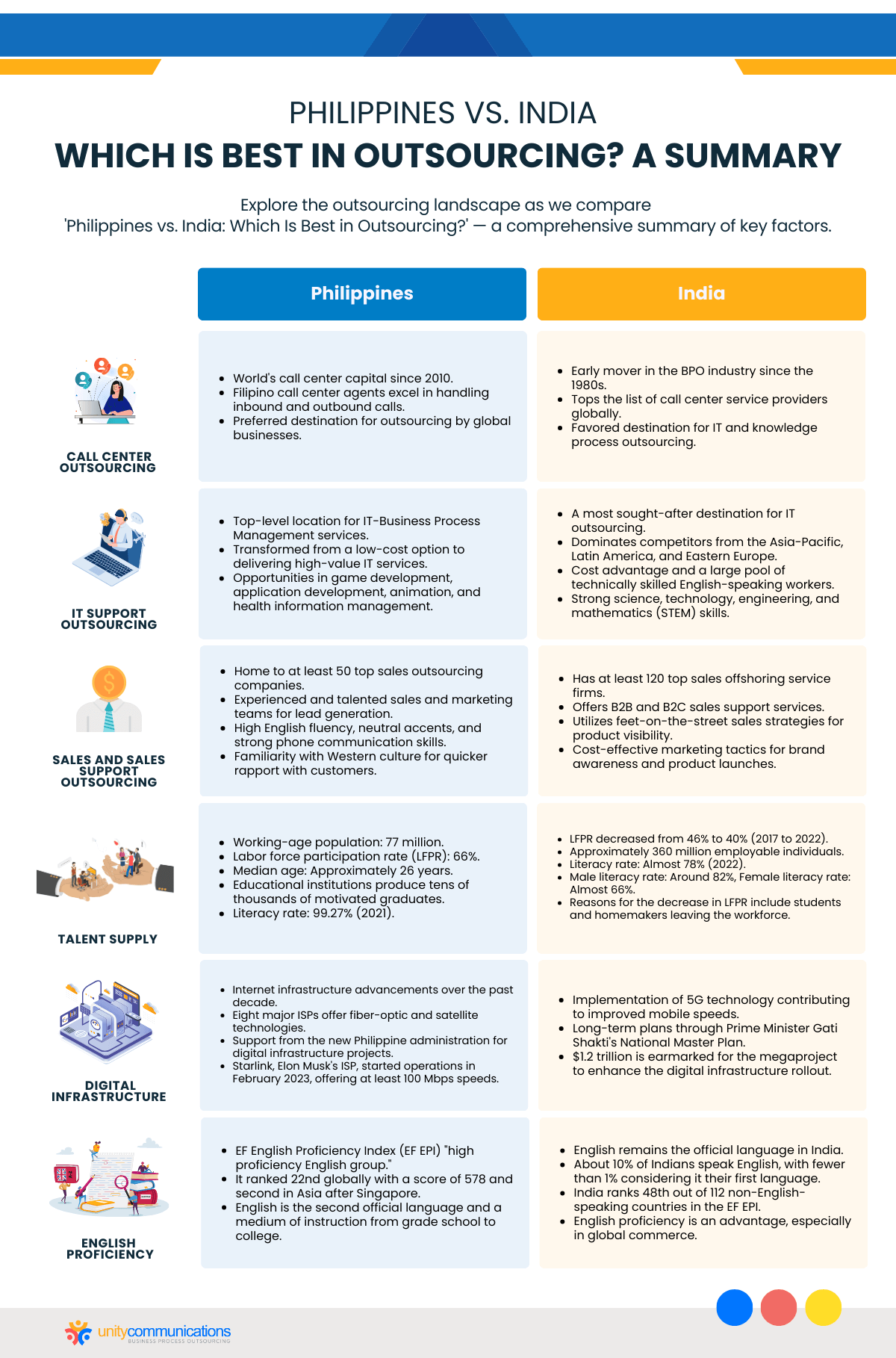Table of Contents
The Philippines and India are likely the first destinations that come to mind when businesses consider offshoring and outsourcing services. Google the words “outsourcing countries,” and the two nations often appear in the top search results.
Both countries abound with offshoring providers offering various outsourcing services to businesses of all shapes and sizes.
This article discusses each country’s strengths and capabilities in areas related to outsourcing, such as call center services, talent supply, labor cost, and English proficiency.
Keep reading to discover which outsourcing destination fits your business best.
Philippines vs. India: Call Center Outsourcing
Let us look at which is currently leading in this area.
Philippines: Customer Service at Its Finest
The Philippines has been the world’s call center capital since 2010. This means businesses worldwide prefer Philippine call center outsourcing over other outsourcing destinations.
Earning this title also indicates that Filipino call center agents are considered the best at handling inbound and outbound calls from existing and potential customers. They deliver an excellent customer experience to enhance consumer loyalty, leading to higher sales and revenue.
Organizations outsource call center services to Philippine business process outsourcing (BPO) companies to improve the buyers’ journey. E-commerce stores, telemarketing companies, telecommunications providers, and financial institutions are some organizations that rely on call centers to provide support and sell products or services.
India: Down To Second Place but Not Out
An article in Mint, an Indian business publication, notes that India was an early mover in the BPO industry. The first call centers began operations in the 1980s as investors took advantage of government perks and the affordable English-speaking workforce present in the country.
The news publication adds that India consistently tops the list of call center service providers. Beyond BPO, India is a favorite offshoring destination for information technology (IT) and knowledge process outsourcing (KPO).
The article, however, points out that despite India being a global outsourcing leader, more foreign companies favor the Philippines for call center offshoring. India has multiple competitors in the international BPO sector, but the Philippines poses the biggest challenge to its outsourced call center operations.
Philippines vs. India: IT Support Outsourcing
Below, we discuss the current situation of the IT outsourcing business in both countries.
Philippines: From Low-cost to High-value Services
Outsourcing Journal, an online publication managed by the German Outsourcing Association, states that the Philippines is a top-level location for IT-Business Process Management (BPM) services and a leader in the global industry.
The article adds that the country transformed from being a low-cost outsourcing option to delivering first-rate IT services (e.g., technical support, infrastructure solutions, and software development). Many companies choose to outsource tech solutions to the Philippines.
In addition, the Philippine IT-BPM sector has several opportunities for high-value services. This is partly due to the Fourth Industrial Revolution and the digitization efforts of the national government and industry. These opportunities include game development, application development, animation, global in-house centers, and health information management.
The publication further notes that IT-BPM firms will focus on optimization, digital transformation, and human resources (HR) upskilling initiatives. These will help ease business transactions and fortify the country’s global IT outsourcing industry positioning.
India: Still the Country To Beat
Business Today states that India is still the most sought-after destination for IT outsourcing, overlapping competitors from the Asia-Pacific region, Latin America, and Eastern Europe. The main reasons for this preference include the cost advantage of outsourcing to the country and its nearly five million technically skilled English-speaking workers.
The Global Services Location Index (GSLI) even ranks the country’s IT offshoring services as the highest on its list since 2004. Issued every two years by U.S.-based management consulting firm Kearney, GSLI measures the attractiveness of countries as potential locations for outsourcing services.
The article notes that the advantage of the Philippines is voice-based support services due to their high English proficiency. In contrast, India’s strength lies in science, technology, engineering, and mathematics (STEM) skills.
The National Association of Software and Services Companies (NASSCOM), India’s trade association for the IT and BPO industries, reports that 80% of U.S. and European firms choose India as their preferred outsourcing hub. Nearly half of Fortune 500 companies outsource software development to Indian software outsourcing providers.
Philippines vs. India: Sales and Sales Support Outsourcing
Check the success of each country when it comes to providing outsourced sales activities such as making sales calls, prospecting for new customers, and negotiating deals.
Philippines: Talented and Sales Marketing Teams
The Philippines is home to at least 50 top sales outsourcing companies. These third-party providers have experienced and talented sales and marketing teams to help companies identify and generate potential leads. The third-party professionals engage these leads and deliver them to the client company’s account executives for sales conversions.
Service providers can also staff clients with competent online marketing coordinators knowledgeable in paid search, search engine optimization (SEO), social media, pay-per-click, and search engine marketing (SEM). They can provide trained sales development representatives for customized inbound and outbound lead generation.
Among the advantages of delegating sales support to the country are its sales and marketing agents’ high English fluency, neutral accents, and phone communication skills. Due to its familiarity with Western culture, outsourced sales teams in the Philippines can establish rapport more quickly with potential customers in the U.S., Australia, Canada, and the UK.
India: Cost-effective and Tenacious Sales and Marketing Teams
India has at least 120 top sales offshoring service firms and agencies. These companies offer sales support services, including business-to-business (B2B) direct sales, distribution network setup, and business-to-consumer (B2C) marketing plans.
Moreover, sales outsourcing companies help startups and small- and medium-sized businesses launch their products and services, sell paid memberships, and perform sales-related processes (e.g., merchant onboarding and app onboarding).
Indian sales support service providers also use feet-on-the-street sales strategies. Commonly known as field merchandising, agents travel to various physical stores to place products and arrange for a more visible presence. Deploying a street team is a cost-effective marketing tactic to build recognition and generate brand awareness for a newly launched product or service.
Philippine vs. Indian Outsourcing: Talent Supply
Both countries have a sufficient supply of employable people for the back-office outsourcing industry. Having a significant number of workers is vital to keep labor costs stable for some time. Let us read the details.
Philippines: Fresh and Young Workforce
The National Economic Development Authority (NEDA), the economic planning body of the Philippines, reports that nearly 51 million Filipinos are open for work as soon as possible. The nation’s working-age population, aged 15 years and older, is 77 million. This indicates that the labor force participation rate (LFPR) is 66% (77 million divided by 51 million).
In other words, close to seven out of 10 Filipinos who can work are willing to work immediately. The labor force mostly comprises millennials and Generation Z since the country’s median age is roughly 26. This means that a company can form an offshore team of young workers who are flexible, trainable, enthusiastic, and familiar with new technologies.
The country’s educational institutions generate tens of thousands of graduates who are educated, motivated, and eager to work. Most Filipinos see formal education and a bachelor’s degree as stepping stones to landing a rewarding career. As proof, the latest literacy rate hit 99.27% in 2021.
India: No Labor Shortage in the Offing
Bloomberg reports that India’s LFPR decreased from 46% to 40% (414 million to 360 million) between 2017 and 2022. This signifies that around half of India’s working-age population has stopped looking for jobs or does not want to be employed. Of these, about 21 million are women who left the workforce. It also means that four out of 10 employable Indians are willing to work.
The online publication adds that the reasons for the LFRP decrease vary. One reason is that jobless Indians are mostly students or homemakers. The number of individuals with marketable skills is shrinking amid rapid technological change.
The Times of India reports that the country’s literacy rate stood at almost 78% in 2022, an improvement from 73% in 2011. The male literacy rate was around 82%, while the female literacy rate was almost 66%.
Simply put, almost eight out of 10 Indians can read and write a basic message and understand more than one language.
Philippine vs. Indian Outsourcing: Digital Infrastructure
Outsourcing contact center as a service (CCaaS) solutions and other processes requires fast and steady internet connections. Find out how each country fares in terms of internet speed and dependability.
Philippines: Faster and Steadier Connectivity
The country’s internet infrastructure advanced over the past decade. Eight major internet service providers (ISPs) offer fiber-optic and satellite technologies to subscribers in the main cities for faster and more stable connectivity.
Improvements in online communications technology increased the country’s internet speed. Based on the December 2022 Ookla Speedtest Global Index report, the Philippines’ fixed broadband median speed increased to 87 Mbps from 81 Mbps in November, a 7% hike month on month. The mobile median speed for this period jumped to 25 Mbps from 24 Mbps.
In addition, the new Philippine administration supports digital infrastructure projects by expediting the approval of building and installation permits. Tech companies and telecommunications providers can thus establish fiber-optic and cellular towers to make connectivity faster and more dependable.
Starlink, Elon Musk’s ISP under SpaceX, is the newest player in the Philippine ISP industry. The company started operation in February 2023, utilizing space satellites to offer an internet connection speed of no less than 100 Mbps.
India: Multi-modal, Holistic, and Integrated Connectivity in the Near Future
The Ookla Speedtest Global Index reports that India registered about 25 Mbps median mobile download speeds in December, compared to 18 Mbps in November. The country moved up 26 spots in the worldwide ranking under this category thanks to the implementation of 5G technology.
In contrast, the nation slid one spot in the global ranking for total median fixed broadband speeds, landing at 81st from 80th in November. India’s performance in fixed median download speeds exhibited a minimal increase to 49.14 Mbps in December from 49.11 Mbps a month earlier.
In the long term, India will continue to improve its internet connectivity through Prime Minister Gati Shakti’s National Master Plan. The national government earmarked about $1.2 trillion for this megaproject to enhance digital infrastructure rollout. Among the provisions in the plan is the faster approval of right-of-way applications to speed up infrastructure building.
Philippine vs. Indian Outsourcing: Labor Cost
Outsourcing companies in the Philippines and India provide affordable service rates to clients partially because of the low salary costs they incur. This enables them to offer lower prices than their competitors.
Philippines: Affordable Salaries
The following are the monthly average salaries of popular outsourced positions in the Philippines:
| Position | Average Monthly Salary |
| Accountant | $515 |
| Back-end web developer | $785 |
| Bookkeeper | $453 |
| Content writer | $524 |
| Customer service representative | $370 |
| Data analyst | $544 |
| Digital marketer | $568 |
| Front-end web developer | $839 |
| Full-stack web developer | $957 |
| Graphic designer | $476 |
| SEO specialist | $777 |
| Technical support agent | $437 |
| Video editor | $574 |
| Telemarketer | $383 |
| Virtual assistant | $525 |
Source: Indeed.com. As of February 24, 2023, salary figures were rounded off and converted from Philippine pesos to U.S. dollars. (Exchange rate: $1 to PHP 55.25)
Based on the table above, the average monthly salary of a Filipino technical support agent is $437, or $5,244 per year. In the U.S., the monthly rate is $3,630, or $51,277 annually, as per Indeed.com’s figures. A company can save $46,033 ($51,277 minus $5,244) annually per resource when transferring IT processes, such as technical support outsourcing, to the Philippines.
India: More Affordable Salaries
Below are the average salaries per month for commonly outsourced roles in India:
| Position | Average Monthly Salary |
| Accountant | $231 |
| Back-end web developer | $774 |
| Bookkeeper | $228 |
| Content writer | $228 |
| Customer service representative | $242 |
| Data analyst | $436 |
| Digital marketer | $247 |
| Front-end web developer | $813 |
| Full-stack web developer | $921 |
| Graphic designer | $225 |
| SEO specialist | $252 |
| Technical support agent | $239 |
| Video editor | $226 |
| Telemarketer | $193 |
| Virtual assistant | $257 |
Source: Indeed.com. As of February 24, 2023, salary figures were rounded off and converted to U.S. dollars from Indian Rupees. (Exchange rate: $1 to ₹82.88)
Using the data above, the average monthly salary of an Indian technical support agent is $239, or $2,868 per year. Comparing it to a U.S. technical support agent with the same $51,277 yearly salary, a company outsourcing to India can save $48,409 ($51,277 minus $2,868) annually per resource.
Labor Cost Comparison
Comparing the two sets of data above shows that India has more affordable labor than the Philippines. The reason is that India has more labor force participants, at around 360 million as of 2022. As previously stated, the Philippines will have approximately 51 million people in 2021. A bigger labor supply means more individuals are willing to work for lower salaries.
Another reason for the lower salaries is that India’s cost of living is lower than that of the Philippines. According to LivingCost.org, a crowdsourced database, the average cost of living in India is about $420, roughly 30% less expensive than in the Philippines at $600. India placed 191st, against 147th for the Philippines, on the list of the world’s most expensive countries.
Note: The above salary figures are estimates. Contact a BPO provider to learn the exact costs and pricing information for outsourcing.
Philippine vs. Indian Outsourcing: English Proficiency
English is the common language of the outsourcing industry. BPO providers offering help desks, customer support, virtual assistance, and data entry services require workers to be fluent in English.
Let us check how each country performs in this category.
Philippines: American-like Accent With a Solid Command of English
Many Filipinos speak and write English with above-average skills. The Philippines is consistently among the EF English Proficiency Index’s (EF EPI) “high proficiency English group.” The nation placed 22nd (with a score of 578) overall in EF EPI’s survey and ranks second in Asia after Singapore.
The European countries dominate the EF EPI list, with the Netherlands, Germany, and Greece covering most of the top 20. The country’s ranking means the country’s English fluency and understanding are on par with those of these progressive nations.
English is the second official language of the Philippines and a medium of instruction from grade school to college. Years of learning the language allow many students to communicate properly in English.
Most Filipino professionals in the outsourcing industry speak English with a neutral accent. They are also well-versed in formal and conversational English. The Filipino English accent has an articulation that differs from that of a native English speaker. Despite the difference, comprehending the Filipino English accent is still easier than other English accents.
India: English Proficiency as Its Edge in Global Commerce
Indian English-language newspaper The Business Standard reports that English remains the country’s official language. English proficiency is an advantage among employers, especially in global commerce, but it is apparent mostly among the nation’s upper class. About 10% of Indians speak English, while fewer than 1% consider it their first language.
The newspaper adds that of the 112 non-English-speaking countries, India ranks 48th, ahead of China at 49th in the EF EPI. The growth of the country’s IT industry over 20 years ago, and its $190 billion outsourcing sector is mainly due to India’s English advantage over its competitors.
The Bottom Line
So which country wins? Which one is better? Where should you outsource your business operations?
The Philippines and India have their own strengths. They both have different benefits to offer their clients. Outsourcing to either destination depends on the business requirements and goals of the companies and organizations considering this strategy.
To learn more about where and how to outsource, contact a BPO provider such as Unity Communications.




